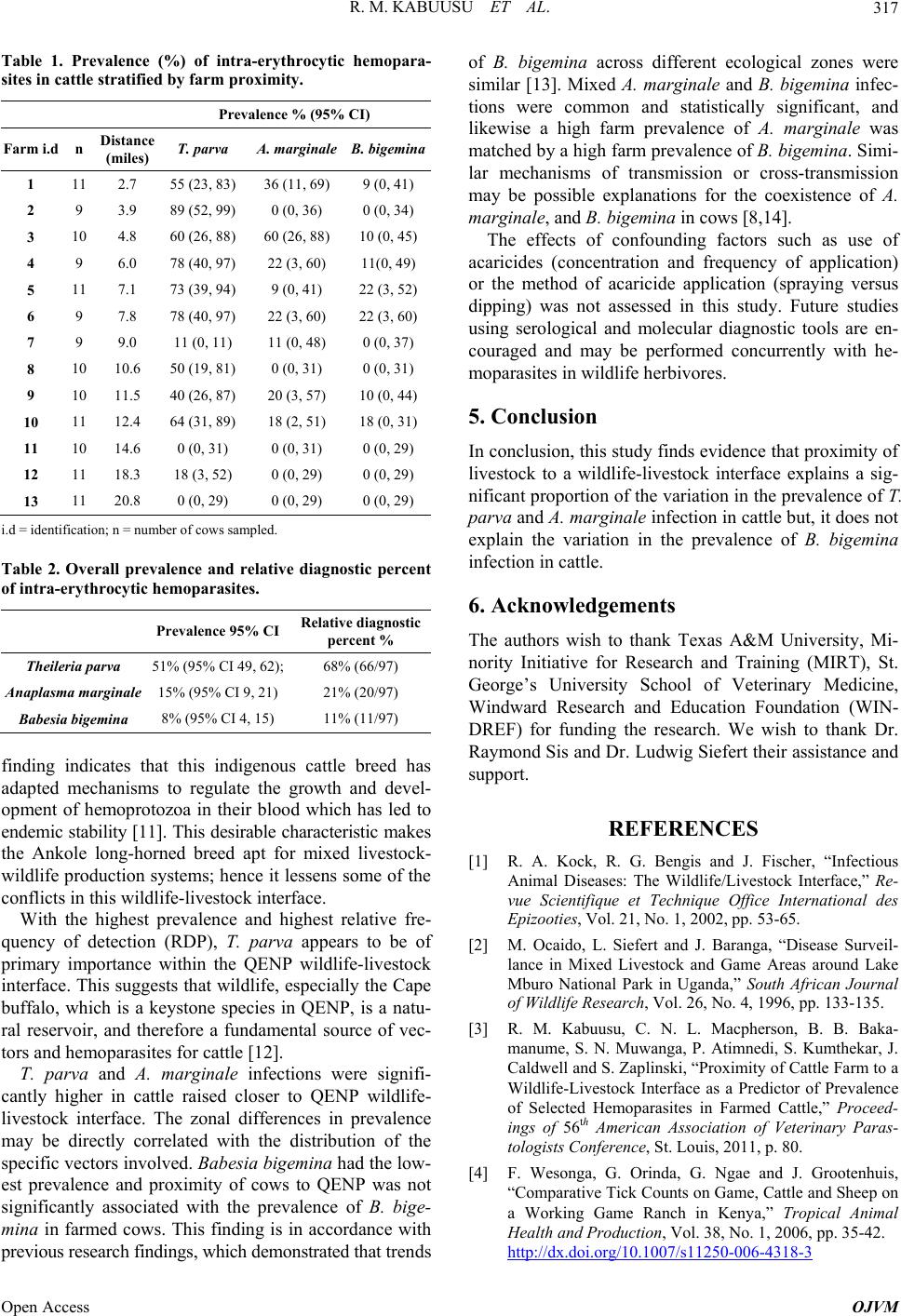
R. M. KABUUSU ET AL. 317
Table 1. Prevalence (%) of intra-erythrocytic hemopara-
sites in cattle stratified by farm proximity.
Prevalence % (95% CI)
Farm i.d n Distance
(miles) T. parva A. marginale B. bigemina
1 11 2.7 55 (23, 83)36 (11, 69) 9 (0, 41)
2 9 3.9 89 (52, 99)0 (0, 36) 0 (0, 34)
3 10 4.8 60 (26, 88)60 (26, 88) 10 (0, 45)
4 9 6.0 78 (40, 97)22 (3, 60) 11(0, 49)
5 11 7.1 73 (39, 94)9 (0, 41) 22 (3, 52)
6 9 7.8 78 (40, 97)22 (3, 60) 22 (3, 60)
7 9 9.0 11 (0, 11) 11 (0, 48) 0 (0, 37)
8 10 10.6 50 (19, 81)0 (0, 31) 0 (0, 31)
9 10 11.5 40 (26, 87)20 (3, 57) 10 (0, 44)
10 11 12.4 64 (31, 89)18 (2, 51) 18 (0, 31)
11 10 14.6 0 (0, 31) 0 (0, 31) 0 (0, 29)
12 11 18.3 18 (3, 52 ) 0 (0, 29) 0 (0, 29)
13 11 20.8 0 (0, 29) 0 (0, 29) 0 (0, 29)
i.d = identification; n = number of cows sam pled.
Table 2. Overall prevalence and relative diagnostic percent
of intra-erythrocytic hemoparasites.
Prevalence 95% CI
Relative diagnostic
percent %
Theileria parva 51% (95% CI 49, 62); 68% (66/97)
Anaplasma marginale 15% (95% CI 9, 21) 21% (20/97)
Babesia bigemina 8% (95% CI 4, 15) 11% (11/97)
finding indicates that this indigenous cattle breed has
adapted mechanisms to regulate the growth and devel-
opment of hemoprotozoa in their blood which has led to
endemic stability [11]. Th is desirable characteristic ma kes
the Ankole long-horned breed apt for mixed livestock-
wildlife production systems; henc e it lessens some of the
conflicts in this wildlife-livestock interface.
With the highest prevalence and highest relative fre-
quency of detection (RDP), T. parva appears to be of
primary importance within the QENP wildlife-livestock
interface. This suggests that wildlife, especially the Cap e
buffalo, which is a keystone species in QENP, is a natu-
ral reservoir, and therefore a fundamental source of vec-
tors and hemoparasites for cattle [12].
T. parva and A. marginale infections were signifi-
cantly higher in cattle raised closer to QENP wildlife-
livestock interface. The zonal differences in prevalence
may be directly correlated with the distribution of the
specific vectors involved. Babesia bigemina had the low-
est prevalence and proximity of cows to QENP was not
significantly associated with the prevalence of B. bige-
mina in farmed cows. This finding is in accordance with
previous research findings, whi ch demonstrated that trends
of B. bigemina across different ecological zones were
similar [13]. Mixed A. marginale and B. bigemina infec-
tions were common and statistically significant, and
likewise a high farm prevalence of A. marginale was
matched by a high farm prevalence of B. bigemina. Simi-
lar mechanisms of transmission or cross-transmission
may be possible explanations for the coexistence of A.
marginale, and B. bigemina in cows [8,14].
The effects of confounding factors such as use of
acaricides (concentration and frequency of application)
or the method of acaricide application (spraying versus
dipping) was not assessed in this study. Future studies
using serological and molecular diagnostic tools are en-
couraged and may be performed concurrently with he-
moparasites in wildlife herbivores.
5. Conclusion
In conclusion, this study finds evidence that proximity of
livestock to a wildlife-livestock interface explains a sig-
nificant proportion of the variation in the prevalence of T.
parva and A. marginale infection in cattle but, it does not
explain the variation in the prevalence of B. bigemina
infection in cattle.
6. Acknowledgements
The authors wish to thank Texas A&M University, Mi-
nority Initiative for Research and Training (MIRT), St.
George’s University School of Veterinary Medicine,
Windward Research and Education Foundation (WIN-
DREF) for funding the research. We wish to thank Dr.
Raymond Sis and Dr. Ludwig Siefert their assistance and
support.
REFERENCES
[1] R. A. Kock, R. G. Bengis and J. Fischer, “Infectious
Animal Diseases: The Wildlife/Livestock Interface,” Re-
vue Scientifique et Technique Office International des
Epizooties, Vol. 21, No. 1, 2002, pp. 53-65.
[2] M. Ocaido, L. Siefert and J. Baranga, “Disease Surveil-
lance in Mixed Livestock and Game Areas around Lake
Mburo National Park in Uganda,” South African Journal
of Wildlife Research, Vol. 26, No. 4, 1996, pp. 133-135.
[3] R. M. Kabuusu, C. N. L. Macpherson, B. B. Baka-
manume, S. N. Muwanga, P. Atimnedi, S. Kumthekar, J.
Caldwell and S. Zaplinski, “Proximity of Cattle Farm to a
Wildlife-Livestock Interface as a Predictor of Prevalence
of Selected Hemoparasites in Farmed Cattle,” Proceed-
ings of 56th American Association of Veterinary Paras-
tologists Conference, St. Louis, 2011, p. 80.
[4] F. Wesonga, G. Orinda, G. Ngae and J. Grootenhuis,
“Comparative Tick Counts on Game, Cattle and Sheep on
a Working Game Ranch in Kenya,” Tropical Animal
Health and Production, Vol. 38, No. 1, 2006, pp. 35-42.
http://dx.doi.org/10.1007/s11250-006-4318-3
Open Access OJVM